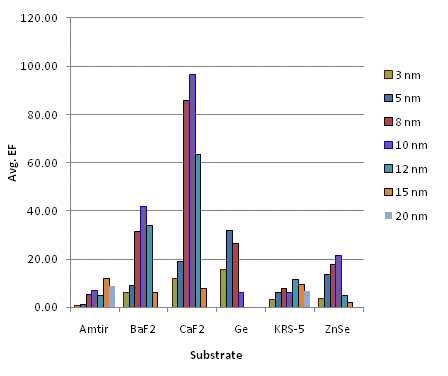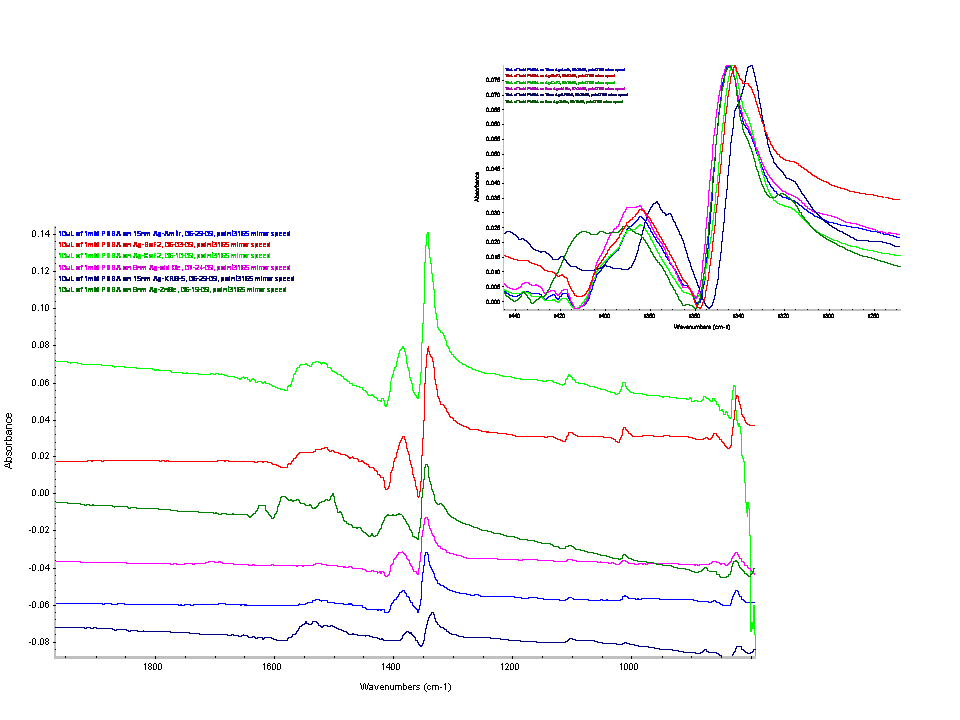Reports: GB5
45862-GB5 Influence of Nanostructure Design on the Structure and Spectroscopic Characterization of Self-Assembled Organic Films Deposited onto Novel Metallic Surfaces
The primary goals of this project are 1) to fundamentally understand nanofilm organization and structure of various chemical systems onto non-planar surfaces and 2) to understand the influence of nanostructure design on the surface-enhanced infrared absorption enhancement phenomena.
Since the last report, the research accomplishments to date include: 1) the fabrication of Ag nano-structured films onto six different infrared substrates, 2) the optimization of the SEIRA enhancement for these substrates and the determination of the correlation between metallic nanoparticle shape and the observed SEIRA activity, and 3) the spectroscopic observation of the impact of non-planar metallic surfaces on the nanofilm organization of monolayers of para-nitrobenzoic acid (PNBA).
Since the beginning of this award period, the grant funds provided for this project have led to a recent manuscript publication in the international journal, Vibrational Spectroscopy (Vibrational Spectroscopy, 2009, 50, 143-151 Special Issue: Prominent Young Vibrational Spectroscopists). Two other manuscripts are currently in preparation. Other successes include four oral presentations (two invited) at national meetings with two more scheduled for March 2010. Two of these presentations were given by undergraduate students. Additionally, the research supported by this PRF has led to four more funded proposals from the U.S. Dept. of Energy (totaling $196,518.00) and the involvement of eight undergraduate students (25% minority) in research.
A brief summary of each accomplishment to date is provided.
1) GLAD fabricated Ag nanostructured films
This subtask is focused on fabricating SEIRA substrates using a custom glancing angle vapor deposition (GLAD) system at USCA.
The overall goal is to correlate the surface morphology of the Ag film with optimal SEIRA enhancement and nanofilm organization onto these non-planar nanostructured surfaces. In this subtask, our goal was to systematically study the growth dynamics of vapor deposited Ag as a function of deposition rate, overall thickness, and the underlying substrate. Although a variety of IR windows have been used for SEIRA, noone has deposited the same Ag film onto multiple substrates to compare which substrate is best. The rate of deposition was 0.01 nm/sec. All depositions positioned the substrate perpendicular to the vapor source. Deposition occurred on seven different IR substrates simultaneously. These substrates represent the most common IR substrates used for SEIRA. These substrates vary in transmission range, chemical inertness, and refractive index. The test molecule used to test for SEIRA activity was a monolayer of PNBA. Additionally, deposition onto glass slides was done to measure surface plasmons for each film by UV/Vis spectroscopy. To date, we have deposited the following thicknesses in triplicate: 3nm, 5nm, 8nm, 10nm, 12nm, 15nm, 20nm. The following IR windows have been analyzed: CaF2, BaF2, ZnSe, Ge, Amtir, KRS-5.
Figure 1 shows representative contact mode AFM images of 10 nm of Ag deposited simultaneously onto the different IR substrates. From these images, it is clear that the underlying substrate determines the growth dynamics of the Ag during the deposition.
Figure 1. 10 nm of Ag simultaneously deposited onto 6 different IR windows.
2) Optimization of SEIRA enhancement
Figure 2 displays the SEIRA enhancement factors for each thickness deposited on the various substrates. The best substrate based on SEIRA enhancement is CaF2. BaF2 is second and has a lower transmission cutoff enabling observations covering a larger spectral range. ZnSe and Ge are also adequate and may be good choices for certain applications. The average overall SEIRA enhancement for CaF2 is 95. The main observable is that all the substrates started low in SEIRA response, reached a maximum at a Ag thickness around 10 nm, and then decreased as the thickness increased. The exception was Ge and its best was between 3 and 5 nm. This implies different growth dynamics for Ge. As shown in Figure 1, the shape and spacing of the Ag particles are quite different based on the underlying substrate used. It is believed that the chemical composition of the underlying IR substrate determines how the Ag collects on the surface. Therefore, a 10 nm Ag film is not the same morphologically on any two substrates. This implies that each crystal must be treated independently to determine what is best for that crystal. This data also implies that optimal SEIRA response is dependent on size and shape of the Ag particles, but also the spacing between particles. Finally, as observed in Figure 3, the enhancement achieved on CaF2 was even greater when the 10 nm of Ag was deposited in a stepwise fashion. For this experiment, 5 nm were deposited. The substrate was allowed to cool under vacuum overnight. The next day, the final 5 nm of Ag was deposited. We believe that the stepwise deposition allows the substrate to maintain a lower surface temperature, which allows for better Ag particle formation. The average SEIRA enhancement for CaF2 using a stepwise deposition is 159. This represents a 67% increase in signal for depositions deposited in a stepwise manner.
Figure 2. SEIRA enhancement factors vs. total Ag film thickness
Figure 3. SEIRA enhancement factors for CaF2 vs. total Ag film thickness. 10 nm step represents the stepwise deposition.
3) Nanofilm organization of PNBA onto non-planar metallic surfaces
Figure 4 shows representative SEIRA spectra of a cast film monolayer of PNBA on the surface of the different IR substrates each coated with 10 nm of Ag. The spectra show two main observables: 1) certain spectral bands are more enhanced depending on the substrate used and 2) the organization of the PNBA on the surface of the Ag film is different as shown from the appearance/disappearance of various spectral bands and spectral shifts of the nitro group in the PNBA molecule. Additionally, peak asymmetry is observed for some of the SEIRA substrates and is thought to be due to particle percolation. This indicates that the monolayer organization is greatly affected by the underlying substrate morphology. Current work is focused on quantifying the relationship of monolayer organization, SEIRA activity, and underlying Ag surface morphology.
Figure 4. SEIRA spectra of a monolayer of PNBA onto six different IR windows coated with a nanostructured Ag layer.








